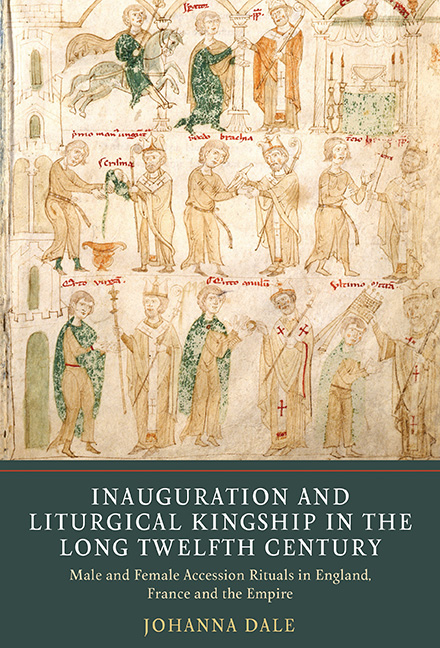 Inauguration and Liturgical Kingship in the Long Twelfth Century
Inauguration and Liturgical Kingship in the Long Twelfth Century Book contents
- Frontmatter
- Contents
- List of Illustrations
- Acknowledgements
- List of Abbreviations
- Timeline
- Genealogies
- Introduction
- 1 Liturgical Texts: The Spoken Word and Song
- 2 Liturgical Rituals: Rubrication and Regalia
- 3 Who and Where? Actors, Location and Legitimacy
- 4 What and When? Consecration and the Liturgical Calendar
- 5 Royal Titles, Anniversaries and their Meaning: The Charter Evidence
- 6 Seal Impressions and Christomimetic Kingship
- Conclusion
- Appendix 1 Editions and Manuscripts of the Selected Ordines
- Appendix 2 Prayer Formulae Incipits
- Appendix 3 Tables of Ritual Elements in the Ordines
- Appendix 4 Brief Descriptions of Royal and Imperial Seals and Bullae
- Bibliography
- Index of Biblical References
- General Index
2 - Liturgical Rituals: Rubrication and Regalia
Published online by Cambridge University Press: 25 October 2019
- Frontmatter
- Contents
- List of Illustrations
- Acknowledgements
- List of Abbreviations
- Timeline
- Genealogies
- Introduction
- 1 Liturgical Texts: The Spoken Word and Song
- 2 Liturgical Rituals: Rubrication and Regalia
- 3 Who and Where? Actors, Location and Legitimacy
- 4 What and When? Consecration and the Liturgical Calendar
- 5 Royal Titles, Anniversaries and their Meaning: The Charter Evidence
- 6 Seal Impressions and Christomimetic Kingship
- Conclusion
- Appendix 1 Editions and Manuscripts of the Selected Ordines
- Appendix 2 Prayer Formulae Incipits
- Appendix 3 Tables of Ritual Elements in the Ordines
- Appendix 4 Brief Descriptions of Royal and Imperial Seals and Bullae
- Bibliography
- Index of Biblical References
- General Index
Summary
The previous chapter focused on spoken and sung elements in the ordines. As we have seen in the context of litanies of saints, such chants, prayers and oaths were associated with ritual acts, in the case of litanies with prostration before the altar. In this chapter, the focus will be on the ritual acts themselves and on items of regalia involved in the myriad mini-rituals, which together made up the inauguration ceremony. It has been noted that prayer formulae in the ordines remained relatively static from the ninth century to the end of the period under consideration here. This is not to say, however, that monarchical inauguration did not evolve after the Carolingian age. To reveal these changes we need to consider another aspect of the ordines: their rubrication. As Jackson has commented, ‘it is the rubrics that change most of all, and it is primarily in them that one must seek the changing perceptions of medieval kingship’. To take Jackson's point further, mutable rubrics had the effect of making static prayer formulae dynamic. They altered the context in which the prayers were to be understood, allowing innovative materials to be woven from traditional threads. A discussion of rubrics and regalia must thus refer to their associated prayer formulae. As changing rubrics could alter the interpretation of century-old prayers, so too could changing cultural contexts alter the perception of the entire rite. Thus, the chapter concludes with a discussion of the female ordines and makes the tentative suggestion that the well-documented growth of Marian devotion in the twelfth century enabled a strengthening of the king's Christomimetic image.
Rubrication
The most striking contrast in rubrication is that found between, on the one hand, the three later imperial ordines (Cencius II, The Staufen Ordo and the Ordo of the Roman Curia) and, on the other, the remaining royal and imperial ordines. These three imperial ordines outline the ritual elements in the imperial inauguration ceremony with a considerably higher level of complexity than in any of the other ordines under consideration. The specificity of these imperial ordines explains their elaboration, at least in part.
- Type
- Chapter
- Information
- Inauguration and Liturgical Kingship in the Long Twelfth CenturyMale and Female Accession Rituals in England, France and the Empire, pp. 68 - 104Publisher: Boydell & BrewerPrint publication year: 2019
